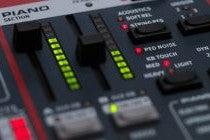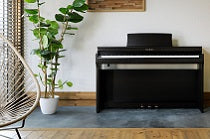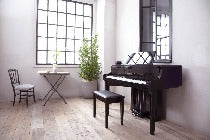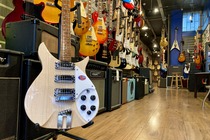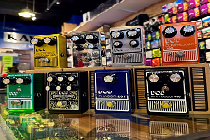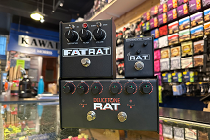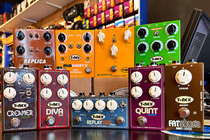One thing we’re often asked about in the store is tone-woods. There is a bewildering amount of information out there offering a buyer information on the ‘best acoustic guitar’ or the merits and one brand against the other. Whilst this information should be considered I would stress that one guitar’s sound will suit a certain player the same guitar will be completely unsuited for someone else. In my experience, all things are not equal!
The most important thing to consider is tonewoods. Tonewoods are the combination of woods that a guitar is made from. Often guitars will have a top wood and a different back/side wood, however it is not uncommon to have guitars made completely of the same type of wood.
So why does this matter? An acoustic's sound and timbre comes from the wood. In the interest of your sanity I will not bore you with too much detail but rather give you a brief overview to get you started.
The most common top wood is spruce. Spruce has a yellowish colour and a bright sound. There are many varieties such as European, Adirondack and Sitka. Generally the price of the instrument will offer a clue as to the quality of the spruce. Spruce is a good all rounder and can handle almost anything.
If a bright sound is not YOUR sound, mahogany might be the wood for you. Mahogany is a rich, warm, dark brown wood that is more commonly used in combination with mahogany back and sides. If you like a prominent bass or warm tone then try mahogany. Consider your sound when listening to guitars. If you have a high voice then a mahogany guitar will compliment it. If your voice is low and gravelly it might and I stress MIGHT not work for you.
Cedar is a popular alternative. It has a quicker sound and more prominent attack. It can give a fuzzy yet warm sound and works really well with mahogany back/sides. It produces a large amount of overtones which gives it it’s distinctive character. Aesthetically it looks similar to spruce but more orange in colour with a tighter grain.
As far as the back & side woods are concerned the popular options are mahogany, maple and rosewood. Mahogany gives you low end and punch when used with spruce whereas rosewood gives you clarity, a clean pronounced bass with crystal clear highs.
Generally speaking, if you’re making guitar focused music then rosewood will sound incredible.It is pronounced, defined and sonically pleasing. If you require a warm, wide sound or something that will blend with other instruments then mahogany will work well. Maple has a very light colour and a tone to match. It’s a ‘toppy’ almost thin sound that sits very well in a mix. Perfect for a pop player or a guitarist with a very busy accompaniment.
I have been deliberately brief in this blog as there is already an overwhelming amount of over complex information about tonewoods and I personally believe you have to try out as many guitars as possible to truly know the right sound for you. I also have only touched on the most common woods to avoid complicating an already daunting subject. You can go into infinite detail about the merits of adirondack versus Engelmann spruce or Indian or Brazilian rosewood however I would rather be on Denmark Street trying guitars than reading about them online. If you would like any more information about tone-woods or would like to discuss your desired sound then please get in contact with me at the store.
Hope that helps!
Henry
The most important thing to consider is tonewoods. Tonewoods are the combination of woods that a guitar is made from. Often guitars will have a top wood and a different back/side wood, however it is not uncommon to have guitars made completely of the same type of wood.
So why does this matter? An acoustic's sound and timbre comes from the wood. In the interest of your sanity I will not bore you with too much detail but rather give you a brief overview to get you started.
The most common top wood is spruce. Spruce has a yellowish colour and a bright sound. There are many varieties such as European, Adirondack and Sitka. Generally the price of the instrument will offer a clue as to the quality of the spruce. Spruce is a good all rounder and can handle almost anything.
If a bright sound is not YOUR sound, mahogany might be the wood for you. Mahogany is a rich, warm, dark brown wood that is more commonly used in combination with mahogany back and sides. If you like a prominent bass or warm tone then try mahogany. Consider your sound when listening to guitars. If you have a high voice then a mahogany guitar will compliment it. If your voice is low and gravelly it might and I stress MIGHT not work for you.
Cedar is a popular alternative. It has a quicker sound and more prominent attack. It can give a fuzzy yet warm sound and works really well with mahogany back/sides. It produces a large amount of overtones which gives it it’s distinctive character. Aesthetically it looks similar to spruce but more orange in colour with a tighter grain.
As far as the back & side woods are concerned the popular options are mahogany, maple and rosewood. Mahogany gives you low end and punch when used with spruce whereas rosewood gives you clarity, a clean pronounced bass with crystal clear highs.
Generally speaking, if you’re making guitar focused music then rosewood will sound incredible.It is pronounced, defined and sonically pleasing. If you require a warm, wide sound or something that will blend with other instruments then mahogany will work well. Maple has a very light colour and a tone to match. It’s a ‘toppy’ almost thin sound that sits very well in a mix. Perfect for a pop player or a guitarist with a very busy accompaniment.
I have been deliberately brief in this blog as there is already an overwhelming amount of over complex information about tonewoods and I personally believe you have to try out as many guitars as possible to truly know the right sound for you. I also have only touched on the most common woods to avoid complicating an already daunting subject. You can go into infinite detail about the merits of adirondack versus Engelmann spruce or Indian or Brazilian rosewood however I would rather be on Denmark Street trying guitars than reading about them online. If you would like any more information about tone-woods or would like to discuss your desired sound then please get in contact with me at the store.
Hope that helps!
Henry

